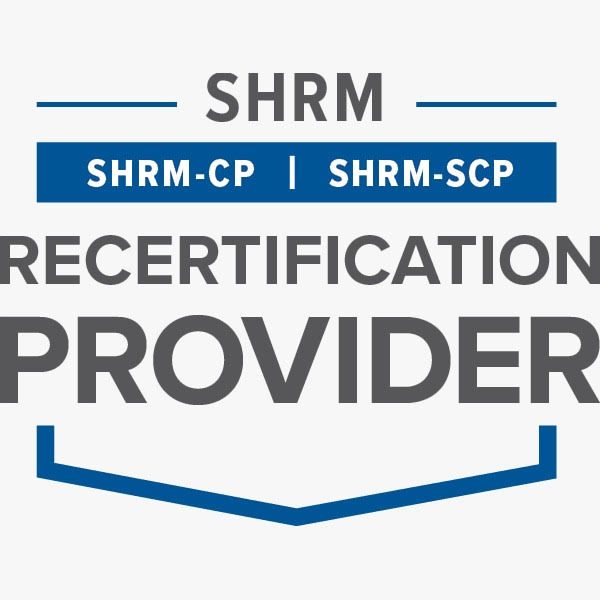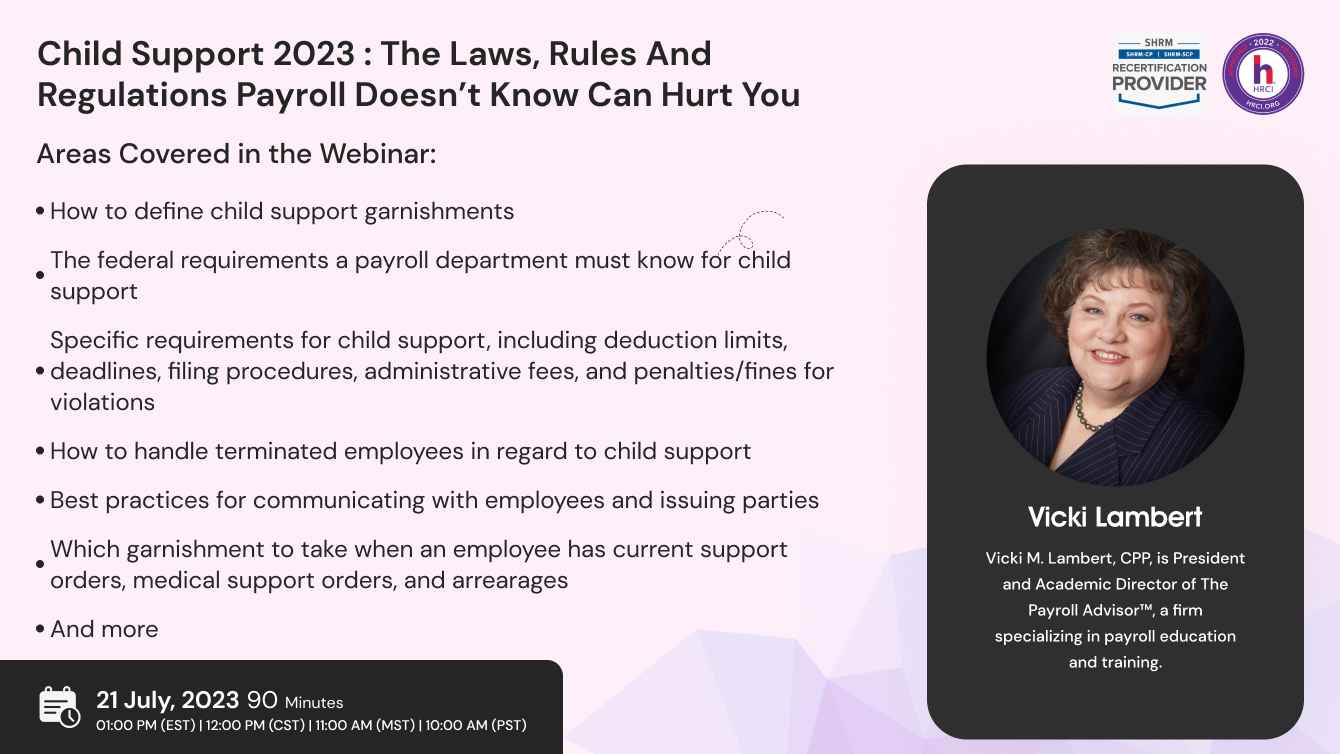Welcome To Biggest Online compliance Platform
Human Resource & Payroll
To bring a national standard to child support withholding laws, the Federal government has enacted laws that require states to adopt certain rules when setting their own standards for implementing child support requirements. These requirements include deadlines for withholding and remitting payments, filing procedures, and penalties and fines for violations.
But the states are free to set up their own rules and regulations as long as they fall within those guidelines and many do differ from the minimum federal requirements. Payroll departments must know both the federal laws and the state laws and must determine which one applies to the child support withholding order.
In addition to these laws and regulations, the federal rules now require that a standard Income Withholding Order (IWO) be used for all child support withholding garnishments. This webinar will review this form and its requirements. And although the IWO can include all the information necessary to comply with the order, employers must familiarize themselves with both federal and state regulations to avoid penalties and liabilities. In addition, state law may address some issues the federal law is silent on such as allowing for the collection of administration fees and how to calculate child support withholding when the employee does not have enough money to cover all support orders in effect. But withholding monies for child support is not the only requirement that applies to providing for a child, medical support orders are required to be process by payroll as well. And these orders have their own rules and regulations on both the federal and state level. In addition, this webinar will give examples of calculating child support.
-How to define child support garnishments
-The federal requirements a payroll department must know for child support
-How state requirements affect child support
-Specific requirements for child support, including deduction limits, deadlines, filing procedures, administrative fees, and penalties/fines for violations
-How to handle terminated employees in regard to child support
-Best practices for communicating with employees and issuing parties
-Which garnishment to take when an employee has current support orders, medical support orders, and -arrearages
-Examples of how to calculate the withholding and prioritize the order of distribution when an employee has more than one type of garnishment
-Best practices for processing child support garnishments in the payroll department
-How to go paperless with child support by receiving electronic withholding orders and paying by EFT
-In-depth discussion of the latest OCSE withholding notice and medical support notice
-Processing medical support notices properly
This webinar focuses on child support garnishments and includes best practices for processing all garnishments but especially child support in a payroll department. The webinar includes the rules and regulations governing child support as well as calculation examples.
This course works through examples of how to determine the actual withholding from wages for child support. This includes doing examples for employees with one, two, and three child support orders in effect, including arrearages. Child support orders are not necessarily processed in a vacuum, and the employee may have other garnishments in effect.
-Payroll Executives/Managers/Administrators/Professionals/Practitioners/Entry Level Personnel
-Human Resources Executives/Managers/Administrators
-Accounting Personnel
-Business Owners/Executive Officers/Operations and Departmental Managers
-Lawmakers
-Attorneys/Legal Professionals
-Any individual or entity that must deal with the complexities and requirements of Payroll compliance issue

Vicki M. Lambert, CPP,
is President and Academic Director of The Payroll Advisor™, a firm specializing
in payroll education and training. The company’s website www.thepayrolladvisor.com offers a payroll news
service which keeps payroll professionals up-to-date on the latest rules and
regulations.
With nearly 40 years of hands-on experience in all facets of payroll
functions as well as over three decades as a trainer and author, Ms. Lambert
has become the most sought-after and respected voice in the practice and
management of payroll issues. She has
conducted open market training seminars on payroll issues across the United
States that have been attended by executives and professionals from some of the
most prestigious firms in business today.
A pioneer in electronic and online education, Ms.
Lambert produces and presents payroll-related audio seminars, webinars, and
webcasts for clients, APA chapters, and business groups throughout the country.
Ms. Lambert is an adjunct faculty member at Brandman University in Southern
California and is the creator of and instructor for their Practical Payroll
Online program, which is approved for recertification hours by the APA. She is
also the instructor for the American Payroll Association’s “PayTrain” online program
also offered by Brandman University.

SHRM-
Pearl Education is recognized by SHRM to offer Professional Development Credits (PDCs) for the SHRM-CPSM or SHRM-SCPSM.
This program is valid for 1.5 PDCs for the SHRM-CPSM or SHRM-SCPSM. For more information about certification or recertification, please visit - portal.shrm.org.

HRCI -
This webinar has been approved for 1.5 HR (General) re-certification credit hours toward California, GPHR, HRBP, HRMP, PHR, and SPHR recertification through the HR Certification Institute.
The use of this seal is not an endorsement by the HR Certification Institute of the quality of the activity. It means that this activity has met the HR Certification Institute’s criteria to be pre-approved for re-certification credit.
Sign up now on pearlacademy.net. Visit pearlacademy.net/webinar to discover a wide range of webinars from industry specialists. Tick on either ‘live webinar’ or ‘on-demand’, and simply click on ‘buy now’ to get enrolled.
You can refer Pearl Education to anyone in your social circle. Explore your industry with your colleagues by getting them signed up on Pearl Education today!
Go for the topic of your keen interest on pearlacademy.net. Tick on ‘live webinar’ and get enrolled! Easy registration, transparent transaction.
You can request for an on-demand webinar that records the live webinar for you. After the webinar ends, you will have full access to the webinar’s recording. You can also explore Pearl Education offline to order your webinar DVDs, flash drives and transcripts.
If you can’t attend the live webinar, simply go for the ‘on-demand webinar’ for the same price! Now, the live webinar recording will be saved in a cloud storage for you to access anytime from anywhere.
Pearl Education offers both hard and soft copies of the webinars. It contains all the highlights as well as comprehensive descriptions of the webinar, so you never miss out a single detail.
After attending the live webinar, your certificate will be emailed to you. You can download it and add more charm to your professional score.
At the end of each webinar, you have the opportunity to interact with your industry experts, where you will get answers to all your queries.
Can’t attend the live webinar? Pearl Education has got you covered! You can always switch to the on-demand webinar from your portal. You can also get your hands on the webinar’s DVD/flash drive and transcript. So order them now!
Pearl Education brings a variety of options for offline learning. Order your DVDs, flash drives or transcripts now to have a lifetime access to Pearl Education webinars. You can also go for on-demand recordings. Download and watch it anytime from anywhere in the world!
